Lectures in Psychiatry
1. Lecture: Introduction to Psychiatry, Classification & Etiology
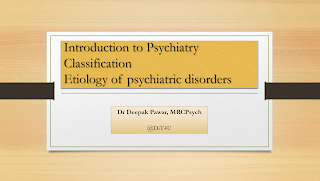
https://youtu.be/i479pF4-Yek
Includes detailed explanation of the following slides:
What is Psychiatry?Role of psychiatristPsychiatry not to be confused with... (difference between Psychiatry & Psychology)Mental health teams (components of multidisciplinary psychiatric teams)Branches of PsychiatryDefinition of mental healthConsequences of mental illnessClassification (of psychiatric disorders)Systems of classificationICD-10 Chapter VDSM-5 multiaxial classificationDifferences between ICD-10 & DSM-5Etiology (of psychiatric disorders)Psychiatric assessment (steps involved)Etiological formulation (based on biopsychosocial model)Formulation: etiology of bipolar affective disorder (an example)Extra slide: Management: investigations + treatment (based on biopsychosocial model)
2. Lecture: Interview techniques, History taking in Psychiatry & Mental State Examination
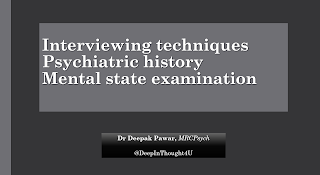
https://youtu.be/lV308KwLjqU
Includes detailed explanation of the following slides:Interview techniques 2/2 (setting the scene, assessment & questioning style)History 3/3 (steps of history taking with examples/significance)Mental state examination 2/2 (steps of MSE with examples/significance)Diagnosis & Formulation (biopsychosocial approach)
3. Lecture: Psychopathology
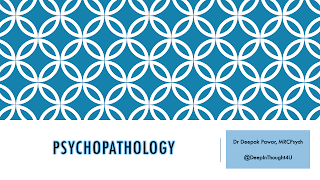
https://youtu.be/Ch7QSdhXJCc
Includes detailed explanation of the following slides:
Psychopathology (introduction, pioneers)Appearance & behaviour 1/2 (attitude, rapport, tics, tremors, chorea, athetosis, dystonia, stereotypies, mannerisms, compulsive acts)Appearance & behaviour 2/2 (mitmachen, mitgehen, gegenhaltan, negativism, ambitendency, catalepsy, echopraxia, stupor)Speech (poverty of speech, pressure of speech, perseveration, circumstantiality, tangengiality, echolalia, coprolalia, mutism, dysarthria/dysphonia/dysphasia)Affect & mood (labile, flattened, congruous/incongruous affect; euthymic, dysthymic, hyperthymic, cyclothymic, depressed, hypomanic, manic, anxious mood)Thoughts (retarded thinking, thought block, perseveration, circumstantiality, desultory thinking, flight of ideas, knight’s move thinking, vorbeireden, verbigeration, neologisms, obsessions/phobias, overvalued ideas/delusions, suicidal ideas)Perception (illusions, hallucinations, depersonalisation, derealisation)Cognition (consciousness, attention & concentration, disorientation, amnesia, apraxia, agnosia)Insight (partial/full/absent)
4. Lecture: Stress, Adjustment disorders & Anxiety disorders
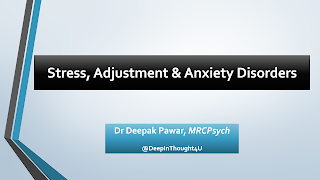
https://youtu.be/JMMzNWsqDiI
Includes detailed explanation of the following slides:
Stress & adjustment disorders (acute stress reaction, adjustment disorder, post-traumatic stress disorder/PTSD: clinical features, associations)Anxiety (normal/abnormal)Yerkes-Dodson curve (relationship between arousal & performance)General symptoms (physical & psychological symptoms of anxiety)Panic disorder (clinical features, associations)Generalised anxiety disorder (clinical features, associations)Phobias (agoraphobia, social phobia, specific phobias: clinical features, associations)OCD/Obsessive-compulsive disorder (nature & examples of obsessions & compulsions; clinical features, associations of OCD)Management (biopsychosocial approach) 5. Lecture: Grief & bereavement reactions, Mood disorders, Suicide & parasuicide (DSH)
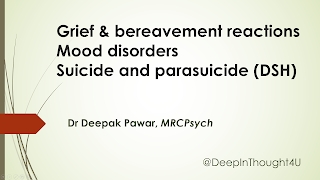
https://youtu.be/2FI9SUVtKJk
Includes detailed explanation of the following slides:
Overview of contents
Grief & bereavement reactions (stages of grief, clinical features & management of abnormal bereavement reaction)
Depression: core features
Depression: biological/somatic symptoms
Depression: psychological/cognitive symptoms
Depression: psychotic symptoms
Mania: core features
Mania: biological/somatic symptoms
Mania: psychological/cognitive symptoms
Mania: psychotic symptoms
Psychopathological differences: mania & schizophrenia (table)
Clinical distinction between hypomania & mania (flowchart)
Mood disorder diagnostic algorithm (flowchart)
Bipolar affective disorder (types 1 & 2, mixed affective state)
Management (biopsychosocial approach for depression/mania/BPAD)
Suicide & parasuicide/DSH (suicide/DSH risk assessment & management)
6. Lecture: Schizophrenia and other psychoses
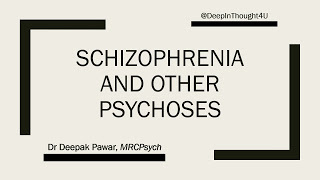
Includes detailed explanation of the following slides:
A) Schizophrenia:
History
Epidemiology
Etiology (genetic, neurochemical & neuropathological theories)
Clinical features
Classification
Diagnosis (first rank symptoms, ICD 10 & DSM 5)
Management
B) Other psychotic disorders
C) Extra slides: MCQ with answers
References/resources:
An Atlas of Schizophrenia, Stefan M., Travis M. & Murray R.M., The Parthenon Publishing Group, London, 2002
https://upload.wikimedia.org/wikipedi...
https://upload.wikimedia.org/wikipedi...
https://upload.wikimedia.org/wikipedi...
https://upload.wikimedia.org/wikipedi...
https://en.wikipedia.org/wiki/Unitary...
https://images.app.goo.gl/D1AaGLjCRtk...
https://upload.wikimedia.org/wikipedi...



